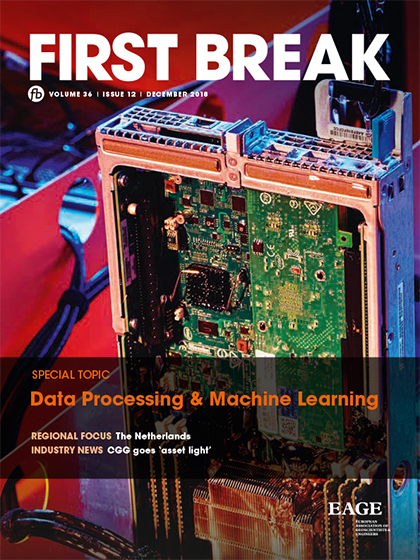-
oa Is Machine Learning taking productivity in petroleum geoscience on a Moore’s Law trajectory?
- Source: First Break, Volume 36, Issue 12, Dec 2018, p. 135 - 141
-
- 01 Dec 2018
- Previous Article
- Table of Contents
- Next Article
Abstract
During the last three decades Wolf and Pelissier-Combescure (1982), Delfiner et al. (1987), Baldwin et al. (1990), Wong et al. (1995), Helle et al. (2001), Bhatt and Helle (2002a,b), Dubois et al. (2007), Li and Anderson-Sprecher (2006), Zhang and Zhan (2017) have shown that neural networks such as multi-layer perceptrons (MLP) can be trained to infer lithology, sedimentary facies, porosity, and fluid saturation as functions of wireline logs. Machine Learning (ML) has been used to classify the seismic waveform (Anderson and Boyd 2004), solve AVO problems (Russell et al. 2002), and to segment seismic facies in 3D volumes (Meldahl et al., 2001; Zhao et al., 2015; Qi et al., 2016). Now, the next generation of ML techniques are transforming the subsurface workflow beyond these applications. This transformation is being enabled by multiple developments from outside the geoscience domain, namely:
- Algorithmic development, driven by AI researchers and tech companies, has given us; i) convolutional neural networks (CNN) (leCun et al., 1990; Krizhevsky et al., 2012) that have transformed the quality of image classification and segmentation tasks, ii) recurrent neural networks (RNN, LSTM) (Hochreiter and Schmidhuber, 1997a,b; Graves et al., 2006; Graves 2013; Sutskever et al., 2014) that have dramatically improved sequence-to-sequence learning, and generative adversarial networks (GAN) (Goodfellow et al., 2014; Zhu et al., 2017) which enable generation of realistic synthetic data and provide a powerful new class of architecture applicable to a wide range of problems.
- Open source libraries such as scipy, tensorflow, pytorch, sklearn, as well as open source geoscience specific libraries such as gempy (de la Varga et al., 2018), and devito (Luporini et al., 2018) are emerging and facilitating application of ML in geoscience.
- Increasing availability and democratization of sub-surface data in national data repositories (NDR) and other sources is enabling the geoscience community to experiment with novel data-analytics techniques, building data science into their problem-solving repertoire.
- GPU enabled high-performance computing, and cloud computing and storage have given a wider audience access to the supercomputing needed to drive the often memory- and compute-hungry algorithms.
- Emergence of data analytics platforms make the application of ML methods more practical for the generalist geoscientist who wants to focus on solving geoscience problems rather than writing bespoke code for each use case. Such platforms integrate data analytics with structured databases and enable users and organizations to apply ML on a large scale while maintaining order, data management, and provenance so that workflows are reproducible.



